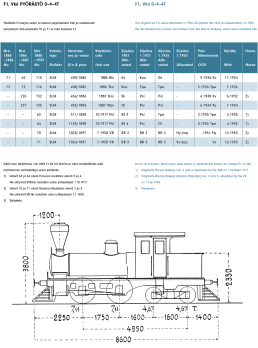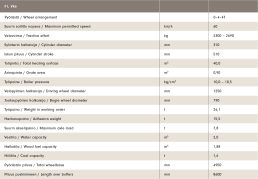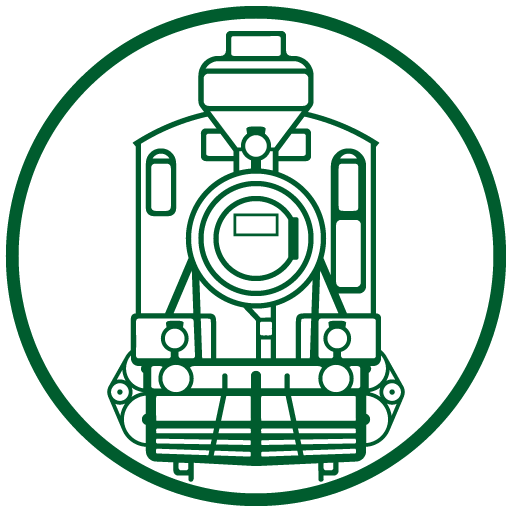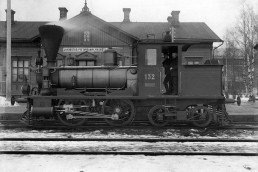Porvoon yksityisrautatiellä oli kaksi samanlaista veturia kuin VR:n F1-sarja. Kuvassa nro 3 jo Valtionrautateille siirtyneenä uudella numerollaan 63.
The private Porvoo Railway owned two locomotives identical to the state railway F1 class 0–4–4Ts. The photo shows no. 3 when in VR ownership and renumbered 63.
Kokoelma Olavi Kilpiö / Olavi Kilpiö collection
Paikallisliikenteesen tarkoitettujen 0–4–4T-vetureiden hankinta ja saanto ensin SVR:lle ja sitten VR:lle on poikkeuksellisen monitahoinen ja sikäli merkillinen historia, että F1-sarjaan kuuluneet veturit eivät koskaan ole kuuluneet sarjaan Vk6 ja päinvastoin. Viisi vetureista on rakenteeltaan vanhempaa mallia (kaikki F1:iä) ja kolme uudempaa mallia (yksi F1 ja kaksi Vk6:tta). Kaikki veturit valmisti sveitsiläinen SLM vuosina 1885–98.
Rautatiehallitus tilasi aluksi kaksi Forney-mallista tankkiveturia Helsingin ja Turun seudun paikallisliikenteeseen. Vetureiden saapuessa niille annettiin numerot 71 ja 72, mutta 71 muutettiin numeroksi 62 jo samana vuonna. Vuoden 1887 numerouudistuksessa numeroiksi tulivat 115 ja 116. Seuraavat kaksi veturia Rautatiehallitus tilasi vuotta myöhemmin Turun–Tampereen–Hämeenlinnan-rautatien lukuun. Ne saivat numerot 226 ja 227, jotka muutettiin seuraavana vuonna numeroiksi 132 ja 133. Seuraavat kaksi veturia tulivat vasta 1917, jolloin valtiolle ostetun Porvoon rautatien veturit 3 ja 4 saivat SVR:n numerot 63 ja 64. Ne olivat valmistuneet vuosina 1888 ja 1898.
Kaikilla edellä mainituilla oli sarjatunnus F1 ja ne hylättiin ennen vuoden 1942 sarjatunnusuudistusta. Viimeiset kaksi Forneytään VR sai 1.7.1950 Rauman Rautatien oston yhteydessä kyseisen rautatien veturikannan siirtyessä VR:lle. Nämä kaksi veturia olivat valmistuneet 1897 ja niillä oli Rauman Rautatiellä ollut numerot 2 ja 3, joista VR:llä tuli 70 ja 71. Sarjamerkiksi annettiin Vk6.
Kaikissa vetureissa oli märkähöyrykattila, Stephensonin luistikoneistot ja tasoluistit. Voitelulaitteena oli Nathan-voitelukoje. Hiekkasäiliöt sijaitsivat käyntisillalla pyörien suojuksien yhteydessä. Etumaiset säiliöt hiekoittivat etumaista vetopyöräparia eteenpäin ajettaessa ja takimmaiset takimmaista toiseen suuntaan ajettaessa. Poikkeuksena Rauman Rautatien vetureilla oli hiekkakupu kattilan päällä.
Jarrulaitteena oli höyryjarru, joka vaikutti molempiin vetopyöräpareihin. Westinghousen ilmajarru asennettiin 1920-luvulla. F1-veturit varustettiin junan höyrylämmityslaitteilla 1900-luvun alkuvuosina. Kaikissa oli alkujaan öljyvalaistus, mutta veturit 63, 64 ja 133 saivat viimeisiksi käyttövuosikseen Aga-valaistuksen. Veturit olivat pääasiassa halkolämmitteisiä, mutta jokainen niistä oli lyhyitä aikoja myös hiililämmitteinen. Alun perin 115, 116, 132 ja 133 olivat halkolämmitteisiä kun taas 63 ja 64 muutettiin halkolämmitteisiksi vuonna 1917.
Veturi 132 varustettiin yhden miehen ajettavaksi vuonna 1927. Käyntisiltaan lisättiin sitä ympäröivät kaiteet sekä tehtiin läpikulkumahdollisuus veturin perästä etupäähän. Kumpaankin päähän tehtiin myös kulkusilta konduktöörin siirtymiseksi vaunusta veturiin tai päinvastoin. Konduktööri velvoitettiin mahdollisuuksiensa mukaan osallistumaan veturinlämmitykseen ja tähystykseen. Kokeilu suoritettiin vuosina 1928–1932 rataosalla Inkeroinen–Hamina.
Vetureita käytettiin aluksi paikallisliikenteessä lähinnä Helsingissä ja Viipurissa sekä eri puolilla maata lyhyillä sivuradoilla, loppuvuosinaan myös vaihtotöissä. Vuosisadan vaihteessa F1 korvattiin Helsingissä ja Viipurissa I1–3-sarjoilla. Muualla maassa tyypillisiä käyttörataosia olivat Kokkola–Ykspihlaja, Pännäinen–Pietarsaari, Pori–Mäntyluoto, Kouvola–Kuusankoski, Inkeroinen–Hamina, Suonenjoki–Iisvesi ja Tampere–Siuro. Siuron päivystäjä veti myös paikallisjunia Tampereelle ja tässä tehtävässä viimeiset käytössä olleet F1-veturit 63 ja 64 päättivät ajonsa helmi- ja maaliskuussa 1935.
Rauman Rautatieltä saadut kaksi veturia sijoitettiin varsin pian Hyvinkään ja Vaasan konepajojen sisäiseen liikenteeseen, mistä tehtävästä ne hylättiin kuitenkin jo 1953 korkean ikänsä ja huonon yleiskuntonsa vuoksi. Veturi 132 on Hyvinkäällä Suomen Rautatiemuseossa.
The suburban 0–4–4Ts are an unusual case in Finland: four were ordered by the state and another four similar engines by two private railways. Five of the locomotives were to an older design (all F1s) and three to a slightly modernised one (one F1 and two Vk6s). All were built by SLM in Winterthur in Switzerland.
The first suburban tank locomotives in Finland were of the Forney type. The first two were intended for local trains in Turku and Helsinki. When introduced in 1885, they were numbered 71 and 72 but the former was renumbered 62 the following year. In 1887 they became nos. 115 and 116. The next two locomotives were ordered for the Turku–Tampere–Hämeenlinna railway and were numbered 226 and 227, only to be renumbered 132 and 133 the following year. An additional two F1 class 0–4–4Ts, built in 1888 and 1898, were added to the motive power fleet as nos. 63 and 64 after the private Porvoo Railway was absorbed by the SVR in 1917. Long after all the F1s had gone, the VR acquired two more of the same type in 1950 when the private Rauma Railway was incorporated. By then this type was thought fit only for shunting duties and was reclassified Vk6 (‘V’ for shunting). On the Rauma Railway these engines were nos. 2 and 3, and were renumbered 70 and 71 by the VR.
These simple expansion engines had Stephenson inside valve gear with slide valves and a Nathan displacement lubricator. The sandboxes were situated above the running plate, set into the wheel splashers. Sand was fed under the front driving wheels when moving forwards and under the rear drivers when in reverse. The engines originating from the Rauma Railway were equipped with a sand dome. Steam braking equipment operated brakes on both driving wheel sets. Oil lamps were used. Nos. 115, 116, 132 and 133 were built as wood burners while nos. 63 and 64 were converted to wood burning in 1917.
Train heating equipment was fitted to these engines at the beginning of the 20th century. Westinghouse air brakes were successfully fitted to nos. 116 and 132 in the 1920s and subsequently applied to the rest of the class. The oil lamps of nos. 63, 64 and 133 were replaced with Aga gas lighting in 1931 and 1932. Modifications were made to no. 132 in 1927 to permit one-man operation by fitting protective handrails around the running plate and by modifying the cab. This provided access for the train conductor, who was obliged to help with the stoking and look-out when the opportunity arose. No. 133 (at least) was rebuilt with a wider cab with projecting sides (such as on the L1 0–6–0T). All engines were coal fired for short periods in their later years.
In the 1880s, these engines were employed on local services in Helsinki and Viipuri and on light passenger traffic on secondary lines. However, the suburban traffic in Helsinki and Viipuri had so intensified by the turn of the century that the light and under-powered F1 0–4–4Ts were no longer able to cope and were gradually replaced by the larger, more powerful I1–3 (later Vk1–Vk3) 2–6–4Ts. The F1s were now relegated to short mixed train workings and shunting duties, for which they proved very suitable on account of their turn of speed. Typical short-haul trains were on the Kokkola–Ykspihlaja, Pietarsaari–Pännäinen, Pori–Mäntyluoto, Kouvola–Kuusankoski, Inkeroinen–Hamina, Suonenjoki–Iisvesi lines and on the Tampere–Siuro main line. The latter witnessed the final duties of the F1 class in 1934–35.
The ex-Porvoo Railway nos. 63 and 64 remained in the Helsinki area until the early 1920s and then were transferred elsewhere for the services mentioned above. The former Rauma Railway nos. 70 and 71, by now class Vk6, were at first used in Tampere but were soon transferred to Vaasa and Hyvinkää works for internal shunting duties. They were withdrawn after three years in 1953.









